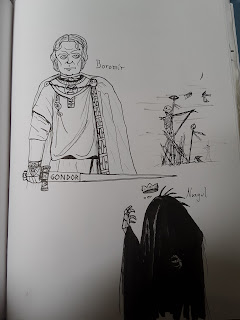Originality is Overrated: The Platypus Reads Part LXXII
As promised, I'm continuing my review of Hellboy Vol. 10 with a discussion of "In The Chapel of Moloch." "In The Chapel of Moloch" is the first Hellboy comic that Mignola has both written and illustrated in some time. As such, it seems to represent Mignola's personal musings in a less guarded fashion.
*Spoilers Ahead*
"In The Chapel of Moloch" presents us with three characters: Hellboy, the Jerry's agent, and Jerry the Artist. Given the cast of characters, Mignola's general theme is quite obvious: this is a meditation on art. The story begins with Jerry's agent calling Hellboy out to Portugal to investigate his client's increasingly weird behavior. Jerry's career has apparently hit a dead end, with the artist only capable of producing copies of Goya. In an effort to save his reputation, Jerry rents a villa in an isolated part of Portugal and holes up in the adjoining chapel to reconnect with his muse. Jerry stops taking calls, begins working exclusively at night, and eventually loses the power of speech except for mumbling the word "Moloch." Upon investigating the chapel, Hellboy discovers that it had once been a sight of Moloch worship and that it had previously been cleansed by the Knights of Saint Hagan. Hellboy and Jerry's agent agree to hide in the chapel and wait until Jerry appears to see what happens. When night falls, Jerry enters the chapel with his new muse, a strange creature that clings to his back and whispers to him. At it's prompting, Jerry continues work on a huge clay statue of Moloch. Hellboy leaps into action in spite of Jerry's vehement protests and destroys both the creature and the statue (which, of course, comes to life and starts pounding Hellboy). The comic ends with Jerry complaining that his career is ruined and that he'll never be "original" and Hellboy assuring him that it could never have ended well any other way.
Taking a look at this short piece as a meditation on art, it becomes clear that Mignola is attacking two things: the emphasis on "originality" in art and the idea that as long as it's "art" anything is justified. According to Jerry's agent, Jerry's Goya inspired paintings are actually quite good and were working towards the goal of reviving interest in Goya and making his work relevant again. Instead of being content to revive interest in an old artist, Jerry insists on being original and his willingness to do anything, even sell himself to the dark powers, just to be original nearly destroys him. It is also interesting that Jerry's patron muse is Moloch. Moloch was traditionally worshiped by child sacrifice. In essence, Jerry has offered up his artistic progeny, the Goya paintings, in hopes of achieving wealth and fame from Moloch. Using Hellboy as his mouthpiece, Mignola bluntly states that "it's not worth it." The message is clear: the obsessive pursuit of originality is a dangerous artistic red herring, and idea that anything is ok so long as it's art is evil. Given the subject matter of the Hellboy series, this doesn't seem like an abstract warning.


Comments